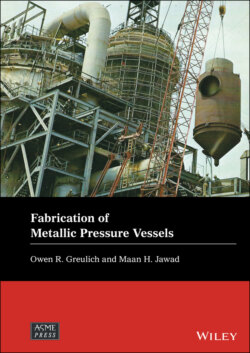Читать книгу Fabrication of Metallic Pressure Vessels - Maan H. Jawad - Страница 23
Example 1.1
ОглавлениеThis example illustrates an actual vessel for which the design approach eliminated a large number of operations as well as fabrication risk by using a much heavier wall than originally specified.
The heavy wall vessel shown in Figure 1.2 is 16 ft long, 30 in. diameter, 4 in. nominal wall, with flat bolted heads, 88 total penetrations, and the full shell length machined inside. Figure 1.3 shows the side views of the same vessel. The vessel might have been fabricated of much thinner material, but was fabricated this way to reduce cost.
The vessel was originally designed using a 1‐3/4 in. thick shell with a number of heavier shell plate inserts with blind drilled and tapped holes for attaching instrumentation. The original design also had an added heavy section at each end with drilled and tapped holes for installation of cover flanges. The fabricator evaluated four approaches before making a proposal. Each approach included the large nozzles welded into fabricated shell sections. The four approaches were (1) as designed originally; (2) a centrifugal casting with flats machined and drilled and tapped for small penetrations, with the internal surface machined after insertion of the large nozzles so as to meet internal tolerance requirements; (3) a single piece, trepanned, heavy forged cylinder with the same approach as (2) for nozzle penetrations, and (4) a rolled and welded heavy plate wall shell with the same approach as (2) for nozzle penetrations.
Figure 1.2 A vessel fabricated with a heavy wall to minimize cost
(Source: Los Alamos National Laboratory)
Figure 1.3 Side views of the vessel in Figure 1.2
The rolled and welded design proved to be the least costly. All of the heavy walled designs eliminated two circumferential welds at the ends, as well as the cost of layout and cutting of holes, and welding in the plates for the small openings. They also reduced the risk of distortion by minimizing the amount of welding required. The centrifugal cast and forged designs had higher costs for the basic cylinder than did the rolled and welded design.
When the user recognized the costs and the tolerance risks associated with welding a large number of nozzle plates, the rolled and welded design was accepted. The rolled and welded shell was produced by a pipe fabricating shop, helping to manage costs.
